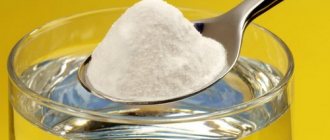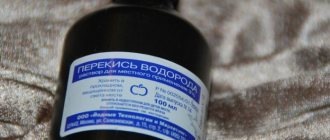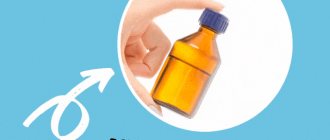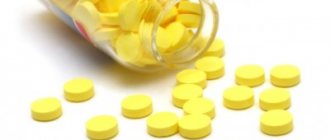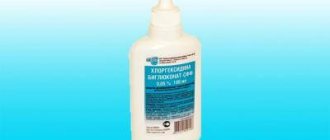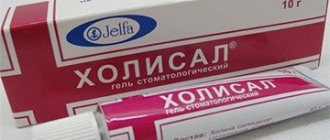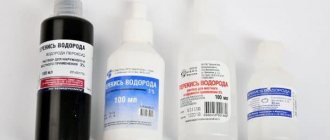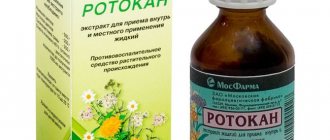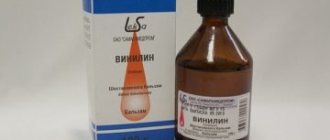Potassium permanganate is an antiseptic proven by many generations, used internally and externally. For ENT diseases and colds, this budget product is used to treat a sore throat. Gargling with potassium permanganate helps relieve pain and effectively washes out harmful microorganisms from the affected mucous membranes. This pharmaceutical product is considered safe and can be used to treat children and adults. To prevent drying out of the mucous membranes, the drug should be used in doses.
Medicinal properties of potassium permanganate
Potassium permanganate (potassium permanganate) is produced in the form of a purple crystalline powder. Before use, the drug must be diluted in water in compliance with certain proportions.
A solution of potassium permanganate has several useful properties:
- Antimicrobial.
- Anti-inflammatory.
- Antiseptic.
- Antifungal.
Potassium permanganate acts as a neutralizer of toxic products released by pathogenic bacteria during their life processes. The product dissolves well in water, after which a specific chemical reaction occurs. As a result of interaction with the liquid, oxygen is released, which causes a pronounced disinfecting effect when a sore throat occurs.
Is it possible to gargle with potassium permanganate?
It is allowed to use potassium permanganate for gargling from the age of 6 years. Its use will bring positive results for various ENT diseases:
- tonsillitis;
- tonsillitis;
- pharyngitis.
With the development of these pathologies, a solution of potassium permanganate will help destroy pathogenic flora and speed up the healing process. The drug disinfects the surface of the tonsils and has drying properties.
. The product can be used alone or combined with various medications.
Despite the variety of modern antiseptics, potassium permanganate still remains a popular remedy used to combat pathogenic bacteria in various medical fields.
Methods for preparing the medicinal composition
There are various methods of treatment with potassium permanganate solutions. A sore throat will benefit from:
- composition with potassium permanganate and water;
- combination with added iodine;
- alternating a solution of potassium permanganate with hydrogen peroxide.
To prepare the monocomposition, several crystals of potassium permanganate are dissolved in a glass of warm boiled water. The product should acquire a characteristic pale pink color. This solution can be made even more effective by adding no more than 2 drops of iodine to it.
Please note that the solution should be a slightly pale pink color. Just add a few crystals of potassium permanganate and be sure to stir well.
The number of procedures performed during the day is determined by the type of disease. So, gargling with potassium permanganate for sore throat is carried out up to 5 times a day; for scarlet fever, tonsillitis, 2-3 sessions will be enough.
In the case of the development of pharyngitis, purulent laryngitis, a combination of two solutions - potassium permanganate and hydrogen peroxide - has a pronounced therapeutic effect. A weak solution of potassium permanganate is alternated with a peroxide solution (1 tablespoon of the component per glass of non-hot boiled water). This treatment regimen allows you to clear the tonsils and root of the tongue from bacterial plaque.
Before using potassium permanganate solutions for the treatment of ENT diseases, it is necessary to obtain specialist approval. Only an experienced doctor will tell you whether this substance can be present in the general treatment regimen.
How to cure stomatitis with baking soda
In order to understand how appropriate the therapeutic use of soda is in a particular case, you need to visit the dentist's office.
If there are foci of infection caused by third-party diseases, such as caries, tartar or gingivitis, then they should be eliminated first. It is also worth consulting with a specialist and finding out whether in this case there are any restrictions on the use of soda-containing products.
Ulcers on the mucous membrane due to stomatitis
After the root cause of the disease has been eliminated, the patient is prescribed a soda rinse.
The solution is prepared in the ratio of 1 glass of boiled water to 1 teaspoon of soda. The first days, rinsing is carried out every three hours, then the frequency is reduced to 5 times a day. Do not eat or drink for 15 minutes after the procedure.
If necessary, you can increase the concentration of the solution to two teaspoons per 200 milliliters of water. However, at the same time it is worth making sure that there are no factors that irritate the mucous membrane. During the treatment period, you should exclude salty, sour, spicy and sweet foods from your diet.
In order to speed up the healing process, the patient may be prescribed additional rinsing with infusions of medicinal herbs - chamomile, calendula or St. John's wort.
If after 2-3 uses of soda rinse the situation does not improve, you should consult a doctor again and choose medication!
A person of any age can get stomatitis, and children of primary preschool age are among them. In addition, this disease is much more severely tolerated by children than by adults and is accompanied by the following symptoms:
- increased body temperature;
- refusal of food and water;
- Sleep disorders;
- nervousness caused by a feeling of discomfort.
Important nuances of treatment with potassium permanganate solution
During treatment with potassium permanganate solutions, it is important to follow some rules. This will ensure safe use of this substance and eliminate unwanted effects.
During the procedure, you should adhere to the following recommendations:
- To prepare a solution of potassium permanganate, use glass containers (this will help prevent unwanted chemical reactions).
- Do not touch the powder with unprotected hands.
- Make sure that manganese crystals are completely dissolved in water (failure to comply with this point may result in the development of burns to the mucous membrane).
- Use only fresh medicinal composition, renewing it several times a day.
- Sessions should be carried out after meals (at least half an hour later).
- Perform one rinse for 30 seconds, then spit out the liquid.
- Avoid swallowing the medicinal composition.
- After completing the procedure, refrain from consuming any food or drinks for 30-40 minutes.
When rinsing, your head should be tilted back and your tongue should stick out as far forward as possible. In this position, the solution will be able to penetrate deeply into the throat and disinfect the areas of greatest accumulation of bacteria.
The average duration of the entire procedure is about 5 minutes. When preparing the medicinal composition, you should not deviate from the recommended proportions and increase them without permission. Otherwise, the likelihood of developing vomiting, stool disorders (diarrhea), burning in the throat, and sharp spasms in various parts of the abdomen increases. It is also unacceptable to use hot liquid for the procedure - this can lead to the development of burns to the mucous membrane and an increase in body temperature.
The therapeutic effect of rinsing is enhanced by lubricating the tonsils with vegetable oils of sea buckthorn or rose hips. For one treatment you will need at least 1 teaspoon of this product. Oils also help prevent drying out of the mucous membranes.
It is important to know that rinsing with potassium permanganate can negatively affect dental health. In this regard, you can use this product without harm to tooth enamel for no more than 2 days.
Potassium permanganate for toothache and problems with the oral mucosa
Periodontal disease
Never wrap a sore spot in scarves, do not apply heating pads, or sleep on a sore cheek, as your face may “get better” by a third overnight.
In my practice (I once worked as an oral and maxillofacial surgeon), there was a case when a woman suffering from toothache was brought to the department. To escape the pain, she slept all night, leaning against the warm radiator. And when we saw her, we ourselves almost suffered from periodontal disease... In general, it is more appropriate to tell this story in the anecdote section. But here's the consequences of that dream - in the horror section! Therefore, having understood the first rule: “Never warm the sore spot from the outside,” learn the second: “Always warm it from the inside!” It’s paradoxical, but the fact remains: hot rinses are useful for almost all dental diseases! Just remember: the rinse must be hot (within reason, of course), and it is better if it is an infusion of medicinal herbs - sage or chamomile - or a pale pink solution of potassium permanganate. It is better not to use baking soda. Although it disinfects well, when used privately it can burn the oral mucosa, and in case of periodontal disease it is generally harmful.
Well, now about rinsing as a process. What he imagines is not at all what is commonly thought: not a loud gurgle over the sink. (We’re not treating the throat, but the teeth, so we’ll arrange hot baths just for them.) Let’s put some healing solution on the cheek and... sit down to watch TV. As soon as the liquid cools down, it needs to be spat out and replaced with a new one. One procedure requires 1 glass of rinsing solution. In general, such procedures need to be done at least 5-10 per day.
I will probably upset some by saying that rinsing with alcohol, cognac and other strong drinks has nothing to do with hot rinsing!
Pulpitis
If you periodically suffer from toothache that radiates to your ear or temple, if it bothers you at night and occurs due to temperature changes, it is likely that you have pulpitis.
Pulpitis is inflammation of the inner part of the tooth (pulp) as a result of caries or injury. It is likely that there is a cavity in the tooth. It needs to be cleaned of food debris and then washed with a warm pink solution of potassium permanganate. After this, fill the cavity with cotton wool, which should be changed after each meal. Before visiting a doctor, it is not advisable for the patient to drink coffee, cocoa, or alcohol. It's better to sleep half-sitting.
Herpetic lesions of the mucous membranes of the mouth
For this unpleasant disease, rinsing the mouth with a pale pink solution of potassium permanganate is prescribed. The procedure is carried out twice a day for a week: after meals and at night. If the disease does not subside, the treatment time is extended.
- Treatment of wounds with potassium permanganate
- Potassium permanganate will help with male diseases
Contraindications and side effects
Gargling with a solution of potassium permanganate has certain limitations. Contraindications to the use of potassium permanganate include:
- the patient has an individual intolerance to the product;
- the patient's age is less than 6 years;
- thyroid dysfunction;
- period of childbearing and lactation.
Side effects of using manganese-based gargling solutions can manifest themselves in the form of changes in the color of the mucous membranes, swelling, severe pain, and convulsions. If such negative phenomena develop during treatment, the use of solutions should be abandoned.
In case of an overdose of potassium permanganate, pain develops in the oral cavity, esophagus, and stomach. Possible disruption of digestive processes in the form of intestinal upset. In such situations, timely symptomatic treatment should be carried out.
Periodontitis is a dental disease characterized by acute or chronic inflammation of the gums at the root of the tooth. As a rule, it is promoted by untreated caries. If periodontitis is not treated, the tooth may turn out, and severe pain will result. Treatment in a clinic involves surgery and antibiotics, but it is possible to reduce the symptoms of the disease before going to the doctor at home.
The essence of treatment with “grandmother’s recipes” is to relieve inflammation, relieve pain and improve the nutrition of periodontal tissue.
It is interesting that folk recipes are not at all inferior in their effectiveness to pharmaceutical medicines, while remaining accessible to anyone and easy to use.
Sometimes treatment at home is enough to relieve the inflammatory process in the gums, but, basically, this measure is suitable for cases when visiting the dentist for some reason is temporarily impossible. It is impossible to completely cure periodontitis at home, but you can alleviate the condition with great success.
Recipes
Traditional medicine has accumulated many different recipes aimed at treating periodontitis, as a rule, these are herbal medicine, improvised means such as salt, soda or ordinary vegetables.
Most often, treatment consists of rinsing the mouth with solutions, decoctions and infusions. You need to rinse your mouth with emphasis on the affected area.
But you need to remember that it is preferable to combine these prescriptions with a visit to the doctor in order to avoid complications of the disease.
Potassium permangantsovka
Using a solution of potassium permanganate, rinse for periodontitis. Dissolve potassium permanganate in water carefully; it should acquire a rich pink-violet hue. You need to rinse your mouth with potassium permanganate at least 4 times a day; a glass of solution is enough for one time.
It is possible to use a soda solution for rinsing - for it, add half a teaspoon of soda to a glass of warm water. The more often you rinse your mouth with such a solution during periodontitis, the better it will be.
Salt and iodine
If periodontitis occurs with the formation of pus, then it is better to use a rinse based on salt and iodine. For a glass of warm water, take half a teaspoon of salt, preferably fine, so that it dissolves well.
A couple of drops of iodine are added to the solution. You should rinse your mouth with salt and iodine an average of four times a day. It is important not to swallow this solution! Instead of iodine, you can add a couple of drops of propolis tincture to the salt solution.
Chamomile
For antiseptic and analgesic purposes, rinses with chamomile decoction. It is better to combine it with yarrow and calendula (all herbs in the amount of 1 tablespoon), pour a glass of boiling water and leave in a thermos for half an hour. Strain the resulting infusion through gauze and rinse your mouth 5 times a day.
Yarrow in this recipe can be replaced with oak bark. With the help of such fees, you can achieve stable remission of periodontitis, if we are talking about a chronic disease.
But chamomile can also be applied to a sore gum as a compress. Alcohol infusions of this flower can be moistened with cotton wool and applied to the sore spot.
Video: chamomile and its beneficial properties
One of the most popular and effective folk remedies for the treatment of periodontitis is plantain, and all parts of this plant are useful. Chewing the root, stem or leaf of plantain has a pain-relieving effect.
For the same purpose, fresh leaves can be applied to the swollen gum. Rinsing with plantain infusion also helps well with periodontitis.
Sage
Sage as a decoction relieves any toothache well. For periodontitis, 1 tablespoon of sage herb should be poured with a glass of boiling water and left for an hour.
You can rinse your mouth with this infusion twice a day or take a tablespoon 3 times a day. You can combine these two methods by additionally applying a cotton wool soaked in a warm infusion to the sore spot and holding it until it cools.
Video: healing properties of sage
Thyme
A decoction of thyme for periodontitis is prepared as follows - 2 tablespoons of dry herb are poured with a glass of boiling water and heated over a fire for no longer than a minute.
When the broth cools naturally, it needs to be strained and poured into a thermos. You need to rinse your mouth with a warm thyme decoction about 4 times a day, being careful not to swallow it.
Video: beneficial properties of thyme and its correct collection
Herbal medicine for the treatment of periodontitis includes mint decoction.
To prepare it, add 2 heaping tablespoons of dry herb to 2 glasses of water and boil the mixture in a water bath. You need to rinse your mouth with the resulting decoction until your general condition improves 4 times a day.
Based on ordinary onions, there are several folk recipes for the treatment of periodontitis. For example, it is advised to soak a cotton swab in onion juice and apply it to the sore spot or into the cavity of the tooth if caries has severely destroyed it.
But dentists consider this method dangerous, because onion juice can be very hot, and therefore can corrode periodontal tissues, and as a result, serious surgical treatment will be required.
Rinsing your mouth with onion skins is a much more gentle and completely safe method aimed at relieving pain.
To prepare the decoction, you need to take 3 teaspoons of onion peel (chopped and washed), pour half a liter of boiling water, bring the mixture to a boil, and turn it off, then let it brew for at least 8 hours and strain. Rinse your mouth several times a day, depending on the intensity of the pain.
In the treatment of chronic periodontitis, or rather, to get rid of toothache that contributes to this disease, garlic is used.
Traditional medicine advises in this case to rub the back of the wrist of the hand opposite the diseased tooth with garlic, apply a cloth with already chopped garlic on top and bandage everything tightly. Wait until the toothache subsides, but you cannot keep such a garlic compress for longer than half an hour.
Video: what are the benefits of garlic?
Tincture of calamus and propolis
The positive properties of calamus and propolis tincture extend not only to the elimination of pain due to periodontitis. If you mix them, the resulting solution will seal microcracks in tooth enamel.
This is due to the fact that calamus has an analgesic effect, and propolis has the ability to fill cracks in teeth.
Therefore, for dental problems, these two products are usually used together. But you cannot immediately prepare a tincture of calamus and propolis together; they must be prepared separately and in different containers.
To prepare one tincture, you need to take half a glass of crushed calamus roots and pour half a liter of vodka over them, then leave for a week in a dark place. Propolis tincture is prepared in a similar way - 10–20 grams of propolis (also crushed) is poured into half a liter of vodka and also infused for a week in the dark.
Mixing is carried out in the following proportions - add 1 teaspoon to 1 tablespoon of calamus tincture and rinse the sore spot in the mouth with this for a couple of minutes. So you can use tinctures of calamus and propolis for a month, rinsing your mouth before bed or during attacks of pain due to periodontitis.
Propolis can also be used separately, for example, dissolve a teaspoon of the prepared alcohol tincture in a glass of warm water and rinse with the resulting solution three times a day for a week. Or take a piece of propolis, knead it with your fingers into a small cake and apply it to the sore gum for a couple of hours.
Video: propolis
If periodontitis is chronic, it is better to purchase natural birch tar at the pharmacy in case of exacerbations. It has some burning sensation, but the soreness and redness of the gums when using it disappears after a couple of days, the swelling subsides, and they become stronger.
Treatment with birch tar works like this: in the morning and evening, after brushing your teeth, not only the gums at the junctions with the teeth, but also the entire oral mucosa should be carefully treated with a cotton swab or brush dipped in tar. This procedure can be repeated with each exacerbation of periodontitis.
One of the oldest recipes for relieving pain from periodontitis is turnip decoction. To prepare it, take 2 tablespoons of grated turnip, which you need to pour a glass of boiling water and simmer over low heat for 5 minutes. The finished broth should be cooled and the mouth should be rinsed with it.
Inflammation of the mucous membranes of the oral cavity - - occurs when infected with bacteria, yeast and the herpes virus. If treatment is incorrect, the acute form of the disease becomes chronic. In this regard, it is important to carry out therapy appropriate to the type of infection. In addition to antibacterial, antiviral and antimycotic medications, rinsing the mouth with an antiseptic is mandatory. Let's look at how to rinse your mouth for stomatitis.
How to rinse your mouth with stomatitis?
There are many compositions for mouth rinsing for stomatitis. Some of the recipes are developed by traditional medicine, others are offered by pharmaceuticals. Let us note the most popular and effective antiseptics:
- An alcoholic or water infusion of herbs
calendula, sage, chamomile flowers or St. John's wort is made at the rate of 1 teaspoon of herbal raw materials per 1 glass of liquid (water, vodka). The frequency of use of the product is at least 6 times a day. - Chlorophyllipt
is an alcoholic tincture of eucalyptus leaves. To rinse, dilute a tablespoon of product in 300 ml of water. Chlorophyllipt can be used in the treatment of children. - Aniline dyes
(preferably a solution of methylene blue) are used in mouth rinses after each meal. - Miramistin, Chlorhexidine
are used both for rinsing the mouth and for irrigating (wiping) inflamed areas.
How to rinse your mouth with severe stomatitis?
In rare cases, the inflammation in the mouth is so severe that the patient stops eating. For severe forms of stomatitis, the following remedies are recommended:
Is it possible to rinse your mouth with potassium permanganate if you have stomatitis?
The answer to the question is yes, it is only important that the rinsing solution has a light pink tint, otherwise you can get a burn to the delicate mucous tissues.
• Library • Articles • Is it possible to rinse your mouth with potassium permanganate after tooth extraction?
If your doctor has not prescribed you to rinse your mouth with a solution of potassium permanganate after tooth extraction, then you do not need to do this. Such a procedure can entail washing out a blood clot from the hole remaining in the place of the extracted tooth, slow down its healing and even cause bleeding. Rinsing with a 0.1-0.2 percent solution (pink) of potassium permanganate is usually recommended for various purulent inflammatory processes in the oral cavity, including gingivitis (inflammation of the gums), as well as in case of a jaw fracture (after applying a splint). The doctor also prescribes this procedure if the patient experiences bad breath.
In all these cases, you should rinse your mouth with a solution of potassium permanganate 3-4 times a day, alternating it with solutions of other antiseptics: hydrogen peroxide, furatsilin, and only for the time recommended by the doctor. Prolonged exposure to a solution of potassium permanganate can cause dry mouth. I would also like to warn you that using a solution of a higher concentration than it should (dark purple in color) results in a burn to the oral mucosa.
Dentist G. P. Makarova
Article “Is it possible to rinse your mouth with potassium permanganate after tooth extraction?” from section
During the off-season, the human body is most susceptible to the negative effects of pathogenic microflora. When you have a cold, the mucous membranes that are first affected are the pharynx, pharynx, larynx, and tonsils. In these situations, homemade gargling with potassium permanganate comes to the rescue. Weak solutions of potassium permanganate not only quickly eliminate pain, but also contribute to the mechanical leaching of pathogenic microbes from the nasopharynx and throat. This pharmaceutical product is safe, but to achieve a healing effect it should be used in doses to avoid drying out the mucous membranes.
Every person's home medicine cabinet contains potassium permanganate, which is very popular due to its wide availability. Potassium permanganate is produced by pharmaceutical companies in the form of small purple crystals. To obtain a medicinal solution, the pharmaceutical product must be diluted with water in certain proportions (depending on the purpose of use). Gargling with potassium permanganate is the first thing to do at home for colds.
This inexpensive pharmaceutical drug has the following healing properties:
- antimicrobial;
- antiseptic;
- neutralizer of toxic substances;
- anti-inflammatory.
The principle of action of potassium permanganate is that when mixed with water, a chemical reaction occurs with the release of oxygen. It is this component that has a pronounced disinfecting effect. Despite the large number of synthetic agents on the modern pharmacological market, potassium permanganate still remains indispensable in many areas of medicine.
Is it possible to rinse your mouth with potassium permanganate for gum inflammation?
The use of manganese solution for stomatitis is considered effective, since the product has a strong antimicrobial effect.
Hydrocyanic acid (a harmful substance released by bacteria during stomatitis) is oxidized upon contact with potassium permanganate. Regular rinsing of the mouth with potassium permanganate can cure stomatitis.
But it is important to follow safety measures, since if the crystals of the substance are poorly dissolved, a severe burn to the mucous membrane is possible.
The substance is a strong antiseptic that, upon contact with bacteria, destroys them. The chemical formula of potassium permanganate is KMnO4. This product comes in crystal or powder form and can be purchased at a pharmacy with a prescription.
The product cannot be used in this form, as there is a high risk of burns. To treat stomatitis, you need to prepare a solution by diluting the powder in water. Depending on the concentration, the resulting liquid may be light pink or deep crimson.
The drug has the following properties:
- prevents the penetration of harmful bacteria into the blood;
- has an antiseptic, bactericidal, drying, healing effect;
- eliminates the harmful effects of bacteria on the oral mucosa.
Potassium permanganate is often diluted by eye, but there is a recommended proportion: 10 crystals should be diluted per 1 liter of water. The product should be stirred well.
If the solution is light pink, then it is a weak solution, but if it is dark pink, then it is a concentrated - strong solution.
Before use, the crystals of the substance must be completely dissolved; otherwise, a poorly diluted drug can burn the oral mucosa. Solution dilution mechanism:
- 1 liter of water is brought to a boil.
- 5 to 10 powder crystals are added.
- The solution is thoroughly mixed.
The drug is used to treat stomatitis; this drug eliminates microbes in the oral cavity by rinsing. The process should be repeated several times a day, preferably every 2 hours. The procedure should be carried out after each meal, after using toothpaste and brushing.
This remedy has virtually no contraindications, except that a person may have increased sensitivity. Allergies manifest themselves as follows:
- the oral mucosa takes on a different color;
- swelling of the treated area develops;
- you feel pain in the mouth, burning or other discomfort.
Permanganate solution must not be combined in treatment with activated carbon, sugar and other substances that are susceptible to rapid oxidation.
If you have these symptoms or other manifestations that cause discomfort, you should go to a specialist and no longer use permanganate solution for mouth rinsing, as this can lead to an unfavorable outcome. Against the background of an elevated temperature that lasts more than 2 weeks, it is not recommended to postpone a visit to the doctor, in particular to the dentist.
source
September 4, 2020, 16:00 Article expert: Daria Dmitrievna Blinova 15,869
The use of potassium permanganate for stomatitis is explained by its powerful antimicrobial effect.
Due to the tendency to oxidize hydrocyanic acid (a toxic substance secreted by bacteria and other pathogens during stomatitis), the vital activity of harmful microorganisms is inhibited.
Repeated rinsing with a weak solution of potassium permanganate in the inflamed oral cavity allows you to quickly and effectively get rid of the disease.
Potassium permanganate is a strong antiseptic, the effect of which depends on the concentration of the solution used. When interacting with proteins of pathogenic bacteria, permanganate releases atomic oxygen, which forms a complex with them - albuminate.
The result is an astringent effect at low concentrations of potassium permanganate, and an irritating, cauterizing, tanning effect at high concentrations. But if potassium permanganate accumulates inside the body, it will have a hematotoxic effect.
As a result, methemoglobinemia will develop, that is, an increase in the concentration of hemoglobin in the blood.
Potassium permanganate is available in pharmacies with a prescription. Available in crystalline form, intended for dilution in water.
Powder in its pure form is not used to treat stomatitis, since one crystal can cause severe burns. To treat stomatitis, dissolve several crystals in water to obtain a faint pink solution.
Such a liquid will have a bactericidal, healing and disinfecting effect on inflamed tissue.
In the fight against stomatitis in the oral cavity, a weak solution of potassium permanganate is one of the most effective. The product disinfects, anesthetizes, and disinfects affected areas, allowing you to get rid of the disease as quickly as possible. Recipe:
- Boil 1 liter of water.
- Add 5-10 powder crystals.
- Stir the solution thoroughly until the product is completely dissolved, otherwise you can cause a burn to the mucous membrane, which will worsen the course of the disease. You should get a slightly pink solution.
- Rinse your mouth every 2 hours. It is especially important to use a mouth rinse after eating or brushing your teeth with toothpaste.
Potassium permanganate has virtually no contraindications, with the exception of hypersensitivity to the drug. This may manifest itself as the following symptoms:
- swelling and change in color of the mucous membrane;
- the occurrence of sharp pain or persistent discomfort in the affected area.
If such symptoms occur, treatment of stomatitis with potassium permanganate should be stopped and consult a doctor. Calling an ambulance is necessary in the following conditions:
- heat;
- swollen, dark brown to purple mucous membrane;
- diarrhea, pain in the abdomen, esophagus, throat;
- swelling of the larynx with mechanical asphyxia.
The high oxidizing properties of potassium permanganate do not allow its use in combination with activated carbon, preparations with sugar and other easily oxidized ingredients.
Potassium permanganate in the treatment of stomatitis is an effective disinfectant with pronounced:
- antiseptic, drying, wound healing properties;
- the ability to neutralize the toxic effects of microbes on the mucous membrane;
- the ability to prevent pathogens from entering the body through the blood.
If inflammation of the mucous membrane is detected in a timely manner and all recommendations regarding the use of a mouth rinse are followed, stomatitis will go away on the 5th day.
source
Never wrap a sore spot in scarves, do not apply heating pads, or sleep on a sore cheek, as your face may “get better” by a third overnight. In my practice (I once worked as an oral and maxillofacial surgeon), there was a case when a woman suffering from toothache was brought to the department. To escape the pain, she slept all night, leaning against the warm radiator.
And when we saw her, we almost had periodontal disease ourselves. In general, it is more appropriate to tell this story in the anecdote section.
But here's the consequences of that dream - in the horror section! Therefore, having understood the first rule: “Never warm the sore spot from the outside,” learn the second: “Always warm it from the inside!” It’s paradoxical, but the fact remains: hot rinses are useful for almost all dental diseases! Just remember: the rinse must be hot (within reason, of course), and it is better if it is an infusion of medicinal herbs - sage or chamomile - or a pale pink solution of potassium permanganate. It is better not to use baking soda. Although it disinfects well, when used privately it can burn the oral mucosa, and in case of periodontal disease it is generally harmful.
Well, now about rinsing as a process. What he imagines is not at all what is commonly thought: not a loud gurgle over the sink. (We are not treating the throat, but the teeth, so we will arrange hot baths just for them.
) Let's take the healing solution into the cheek and... Let's sit down and watch TV. As soon as the liquid cools down, it needs to be spat out and replaced with a new one. One procedure requires 1 glass of rinsing solution.
In general, such procedures need to be done at least 5-10 per day.
Source: https://lechenie.historyam.ru/desna/mozhno-li-poloskat-rot-margantsovkoy-pri-vospalenii-desen/
Treating a throat with a solution
Many patients, faced with painful symptoms of a sore throat, wonder whether it is possible to gargle with potassium permanganate. For medicinal purposes, it is allowed to use this chemical subject to the rules of caution, since ignoring them can dry out the mucous membranes of the throat.
The active components of the drug allow you to disinfect the membranes of the tonsils, eliminate purulent plaque and pathogenic bacteria, therefore a self-prepared solution of potassium permanganate (2-3 crystals per glass) is quite effective in treating inflammation of the throat.
The use of potassium permanganate for gargling is carried out as follows:
- For medicinal purposes, only freshly prepared solution is suitable.
- To quickly eliminate pain, you can slightly warm up the medicinal mixture.
- Doctors recommend home therapy with potassium permanganate after the main meal.
- The patient's head should be tilted back while rinsing.
- During the procedure, you must pronounce the sound “s”.
- The rinse lasts about 30 seconds, after which the solution should be spat out.
For pharyngitis and laryngitis, you should rinse 4-5 times a day, and for tonsillitis - 2-3 times. It should be remembered that after the procedure it is forbidden to eat for about 30 minutes. To avoid drying out the mucous membranes of the throat, experts recommend applying sea buckthorn oil to inflamed tonsils after treatment with potassium permanganate.
Patients should be aware that this pharmaceutical product has a negative effect on the condition of tooth enamel, which is why it should not be used for more than 2 days.
Despite the beneficial properties of potassium permanganate, if it enters the stomach, irritation of the digestive tract may occur. When you have a sore throat, you only need to gargle with a solution with completely dissolved crystals of the substance. Otherwise, serious burns may occur.
Gargling with potassium permanganate: is it possible or not?
It is important that all crystals are completely dissolved in water, otherwise you may get a burn to the mucous membrane
To get rid of unpleasant sensations in the throat due to pharyngitis and sore throat, you can use a solution of potassium permanganate. This product is good at destroying pathogenic bacteria, drying and disinfecting the mucous membrane of the tonsils.
You can use potassium permanganate solution alone or in combination with other agents. To prepare the solution, you need to dilute 2-3 grains of manganese (no more!) in a glass of warm water. The solution should turn out slightly pink. Remember, a highly concentrated solution will cause burns!
To carry out effective treatment, you can add a couple of drops of iodine to the prepared solution of potassium permanganate. For sore throat, rinse 4-5 times a day, and for scarlet fever 2-3 times.
It is necessary to follow some recommendations for performing this procedure:
- Rinse only with freshly prepared medicinal solution.
- The procedure is performed for 30 seconds, followed by spitting out the liquid.
- Do not swallow liquid while rinsing.
- It is advisable to carry out the procedure after eating. It is recommended to lubricate the tonsils with sea buckthorn oil. You can use other vegetable oil.
- After gargling, you should not eat for 30-40 minutes, otherwise there will be no therapeutic effect.
- It should be remembered that potassium permanganate has a strong effect on tooth enamel, so it is not recommended to gargle for more than 2 days.
Contraindications to gargling and side effects
Gargling as a physiotherapeutic method for treating inflammation in the pharynx is prescribed to all patients. However, there are some contraindications when potassium permanganate cannot be used for this procedure.
It is forbidden to use potassium permanganate solution if you are hypersensitive and side effects appear. Since potassium permanganate has oxidizing properties, it is not recommended to use it with substances that oxidize: coal, sugar, etc.
Main contraindications to gargling:
- Children under 3 years old. Small children do not yet know how to gargle sufficiently, so there is a high probability that the child may swallow the solution or choke.
- Allergic reactions. If you are hypersensitive to potassium permanganate, side effects such as itching, burning, and swelling may occur. If undissolved crystals get on the mucous membrane, this can lead to a chemical burn.
- Thyroid diseases. For hyperthyroidism, iodine is not added to the potassium permanganate solution, and the procedure itself is not prohibited.
In addition, burns can occur when using a high concentration solution. This causes redness and swelling. In some cases, bubbles and a gray film may form. It is necessary to wash off the chemical, cool the affected areas with water and consult a doctor.
You can learn more about the properties of potassium permanganate from the video:
How to properly dilute potassium permanganate
You can also gargle with potassium permanganate for preventive purposes to increase local immunity and develop immunity to infectious and inflammatory diseases. Regardless of the purpose of use, you should know how to make the solution correctly and not harm your health.
Selection of cookware
It must be remembered that food containers are not suitable for these purposes; it is advisable to use glass containers. This caution is due to the fact that potassium permanganate is an active chemical that can enter into oxidative bonds with other materials. To better dissolve potassium permanganate crystals, it is necessary to use boiled warm water.
To avoid skin burns, it is strictly forbidden to handle the substance with your hands. To be on the safe side, doctors recommend straining the prepared solution through gauze folded in several layers. In this way, you can avoid getting undissolved crystals of potassium permanganate into your throat.
Hydrogen peroxide solution
The most pronounced healing effect is achieved with the combined use of potassium permanganate with hydrogen peroxide. To do this, you need to dilute one tablespoon of 3% peroxide in one glass (100 ml), and prepare a weak solution of potassium permanganate in the second. When rinsing, you can alternate healing tinctures. This method of therapy demonstrates good results for purulent laryngitis, since the solution carefully cleanses the tonsils and the root of the tongue from plaque.
When making a solution for gargling, you need to proceed from the following proportions: 10 drops per liter of water. First, you need to pour water into the container, and then add the dry substance. Doctors remind that the dangerous dosage of potassium permanganate for adults is 0.5 g per kg of weight, and for children - 3 g. If the recommended amount of the substance is exceeded, patients begin vomiting, bowel dysfunction in the form of diarrhea, sharp cramps in the abdomen, and a burning sensation in the throat.
As medical practice shows, positive reviews about gargling a sore throat with potassium permanganate prevail, which confirms its healing properties.
How to dilute potassium permanganate
Contact of potassium permanganate with organic substances leads to the release of atomic oxygen. It is oxygen that acts on pathogenic organisms, destroying them. And when restored, the drug forms a complex bond with proteins and has an astringent effect.
Minimal dosages do not harm tissues, but highly concentrated potassium permanganate cauterizes and irritates. Overdose is determined by accompanying symptoms: pain in the throat and digestive tract, vomiting and stomach upset.
The lethal dose for an adult is 0.3 - 0.5 kg, and for children only 3 grams. If the proportions of potassium permanganate in the solution have been violated, ascorbic acid and cyanocobalamin will help neutralize the poisoning.
Preparation of the solution:
- Pour warm water into a glass;
- Using a slightly moistened toothpick tip, take a few grains of powder and add to the water;
- Stir until completely dissolved (solid particles settled to the bottom may cause burns if swallowed);
- Add water if the solution is too saturated (ideally it should be pale pink, almost transparent).
Contraindications to the use of the medicinal solution
Despite the widespread use of potassium permanganate in medicine, this chemical is not indicated for all patients. To avoid adverse reactions in the body, you should be aware of absolute contraindications for use.
Doctors prohibit rinsing the throat with a solution of potassium permanganate in the following cases:
- The presence of individual increased sensitivity of the body to the action of the pharmaceutical product. If this factor is ignored, patients rapidly develop adverse reactions in the form of swelling of the mucous membranes, convulsions, and severe pain.
- Younger age. Children under 3 years of age should not gargle for a sore throat as there is a high risk of swallowing the solution.
- Thyroid diseases.
- Waiting period for a child. It is not advisable to gargle with manganese during pregnancy. During this period, doctors recommend using more gentle pharmaceutical products.
